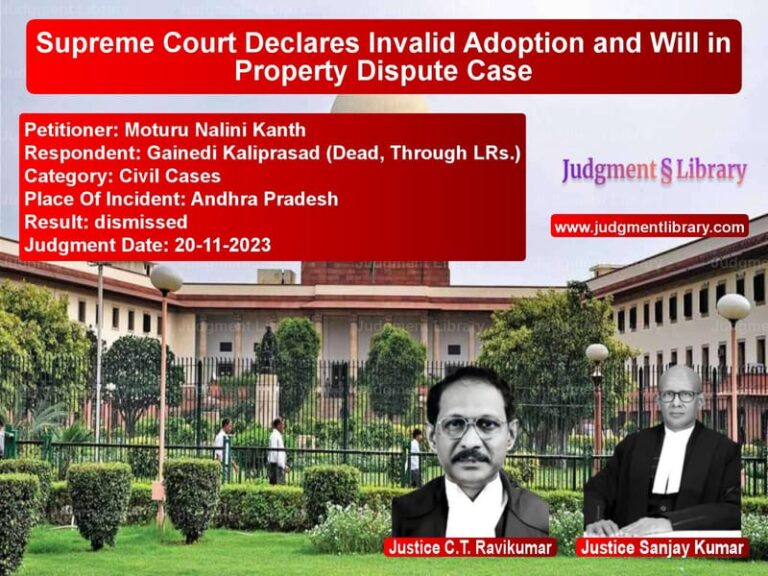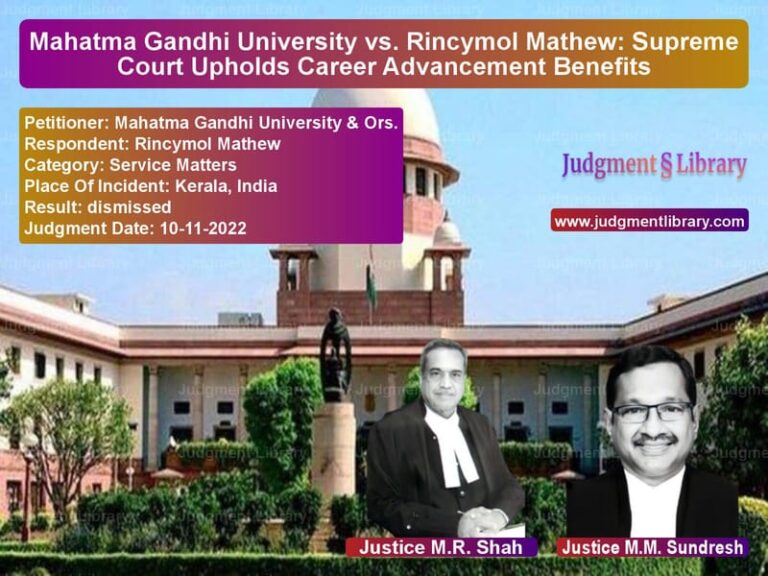Supreme Court Acquits Accused in Punjab Robbery and Murder Case
The Supreme Court of India recently ruled in the case of Amrik Singh & Subhash Chander vs. The State of Punjab, overturning a conviction related to robbery and murder under Sections 302 read with 34 and 392 of the Indian Penal Code (IPC). The case involved the fatal shooting of Gian Chand during an alleged robbery, where the appellants were accused of murder and theft of Rs. 5 lakhs.
Background of the Case
The prosecution alleged that on May 8, 2001, the deceased Gian Chand, along with the complainant Des Raj, was traveling back from the office of the Sub-registrar after completing a property transaction. They were intercepted by three assailants on a scooter, one of whom, identified as Amrik Singh, allegedly fired at Gian Chand’s chest, causing his death. The motive was believed to be the theft of Rs. 5 lakhs stored in the scooter’s compartment.
Following this, the accused were arrested, and Rs. 1 lakh each was recovered from them. They were tried and convicted by the Sessions Court, with their conviction upheld by the Punjab and Haryana High Court. Dissatisfied with these rulings, they appealed to the Supreme Court.
Read also: https://judgmentlibrary.com/ndps-bail-case-supreme-court-upholds-high-courts-order-granting-bail/
Petitioner’s Arguments
The appellants challenged the conviction on several grounds:
- The prosecution’s case relied entirely on the testimony of the complainant (PW1), who identified the accused for the first time in court, without any prior Test Identification Parade (TIP).
- The prosecution failed to prove that Rs. 5 lakhs was indeed present in the scooter and that the recovered cash was connected to the alleged robbery.
- The High Court and Trial Court convicted the accused based on circumstantial evidence without conclusive proof linking them to the crime.
- The recovery of Rs. 1 lakh from each accused was not sufficient evidence to establish their guilt beyond a reasonable doubt.
- No forensic or ballistic evidence directly linked the accused to the shooting.
Respondent’s Arguments
The prosecution maintained the conviction, arguing:
- The complainant (PW1) provided a clear and consistent account of the attack and identified the accused in court.
- The lack of a Test Identification Parade did not affect the reliability of the eyewitness’s testimony.
- The recovery of Rs. 1 lakh from each accused was a crucial piece of corroborative evidence that connected them to the crime.
- Statements from prosecution witnesses supported the claim that the accused had planned the robbery.
Supreme Court’s Observations
The Supreme Court critically analyzed the evidence and focused on key legal aspects, such as:
- The reliability of the complainant’s testimony.
- The necessity of a Test Identification Parade (TIP) when the accused were allegedly unknown to the witness.
- The absence of direct evidence proving that Rs. 5 lakhs was indeed in the scooter at the time of the crime.
- Whether any forensic reports conclusively linked the accused to the firearm used.
The Court noted:
- The prosecution had failed to establish the identity of the accused beyond a reasonable doubt due to the absence of a TIP.
- The recovery of Rs. 1 lakh each from the accused did not conclusively link them to the crime, as no documentary evidence proved that the money was part of the stolen Rs. 5 lakhs.
- The conviction relied heavily on weak evidence and assumptions, rather than concrete proof.
- Forensic examination of the firearm was inconclusive.
Final Judgment
The Supreme Court ruled as follows:
- The conviction was set aside, and the appellants were acquitted of all charges.
- The prosecution failed to meet the burden of proof required for a conviction.
- The accused were to be released immediately unless required in other cases.
Implications of the Ruling
This judgment reinforces several key legal principles:
- Importance of Test Identification Parades (TIP) when eyewitness identification is the primary evidence.
- Convictions must be based on strong, direct evidence, not just circumstantial inferences.
- Burden of proof in criminal cases must be met beyond a reasonable doubt.
- Forensic evidence must conclusively link an accused to the crime before forming the basis of a conviction.
This decision sets a precedent for law enforcement and prosecution to ensure rigorous investigative procedures and avoid wrongful convictions.
Petitioner Name: Amrik Singh & Subhash Chander.Respondent Name: The State of Punjab.Judgment By: Justice M.R. Shah, Justice Aniruddha Bose.Place Of Incident: Fazilka, Punjab.Judgment Date: 10-07-2022.
Don’t miss out on the full details! Download the complete judgment in PDF format below and gain valuable insights instantly!
Download Judgment: amrik-singh-&-subhas-vs-the-state-of-punjab-supreme-court-of-india-judgment-dated-10-07-2022.pdf
Directly Download Judgment: Directly download this Judgment
See all petitions in Murder Cases
See all petitions in Bail and Anticipatory Bail
See all petitions in Custodial Deaths and Police Misconduct
See all petitions in Judgment by Mukeshkumar Rasikbhai Shah
See all petitions in Judgment by Aniruddha Bose
See all petitions in allowed
See all petitions in Quashed
See all petitions in supreme court of India judgments July 2022
See all petitions in 2022 judgments
See all posts in Criminal Cases Category
See all allowed petitions in Criminal Cases Category
See all Dismissed petitions in Criminal Cases Category
See all partially allowed petitions in Criminal Cases Category







